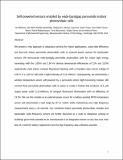| dc.contributor.author | Mathews, Ian | |
| dc.contributor.author | Kantareddy, Sai Nithin R. | |
| dc.contributor.author | Sun, Shijing | |
| dc.contributor.author | Layurova, Mariya | |
| dc.contributor.author | Thapa, Janak | |
| dc.contributor.author | Correa-Baena, Juan-Pablo | |
| dc.contributor.author | Bhattacharyya, Rahul | |
| dc.contributor.author | Buonassisi, Anthony | |
| dc.contributor.author | Sarma, Sanjay E | |
| dc.contributor.author | Peters, Ian Marius | |
| dc.date.accessioned | 2021-02-23T21:45:32Z | |
| dc.date.available | 2021-02-23T21:45:32Z | |
| dc.date.issued | 2019-08 | |
| dc.date.submitted | 2019-07 | |
| dc.identifier.issn | 1616-301X | |
| dc.identifier.issn | 1616-3028 | |
| dc.identifier.uri | https://hdl.handle.net/1721.1/129981 | |
| dc.description.abstract | A new approach to ubiquitous sensing for indoor applications is presented, using low-cost indoor perovskite photovoltaic cells as external power sources for backscatter sensors. Wide-bandgap perovskite photovoltaic cells for indoor light energy harvesting are presented with the 1.63 and 1.84 eV devices that demonstrate efficiencies of 21% and 18.5%, respectively, under indoor compact fluorescent lighting, with a champion open-circuit voltage of 0.95 V in a 1.84 eV cell under a light intensity of 0.16 mW cm−2. Subsequently, a wireless temperature sensor self-powered by a perovskite indoor light-harvesting module is demonstrated. Three perovskite photovoltaic cells are connected in series to create a module that produces 14.5 µW output power under 0.16 mW cm−2 of compact fluorescent illumination with an efficiency of 13.2%. This module is used as an external power source for a battery-assisted radio-frequency identification temperature sensor and demonstrates a read range by of 5.1 m while maintaining very high frequency measurements every 1.24 s. The combined indoor perovskite photovoltaic modules and backscatter radio-frequency sensors are further discussed as a route to ubiquitous sensing in buildings given their potential to be manufactured in an integrated manner at very low cost, their lack of a need for battery replacement, and the high frequency data collection possible. | en_US |
| dc.language.iso | en | |
| dc.publisher | Wiley | en_US |
| dc.relation.isversionof | http://dx.doi.org/10.1002/adfm.201904072 | en_US |
| dc.rights | Creative Commons Attribution-Noncommercial-Share Alike | en_US |
| dc.rights.uri | http://creativecommons.org/licenses/by-nc-sa/4.0/ | en_US |
| dc.source | arXiv | en_US |
| dc.title | Self‐Powered Sensors Enabled by Wide‐Bandgap Perovskite Indoor Photovoltaic Cells | en_US |
| dc.type | Article | en_US |
| dc.identifier.citation | Mathews, Ian et al. "Self‐Powered Sensors Enabled by Wide‐Bandgap Perovskite Indoor Photovoltaic Cells." Advanced Functional Materials 29, 42 (August 2019): 1904072 © 2019 Wiley | en_US |
| dc.contributor.department | Massachusetts Institute of Technology. Department of Mechanical Engineering | en_US |
| dc.relation.journal | Advanced Functional Materials | en_US |
| dc.eprint.version | Author's final manuscript | en_US |
| dc.type.uri | http://purl.org/eprint/type/JournalArticle | en_US |
| eprint.status | http://purl.org/eprint/status/PeerReviewed | en_US |
| dc.date.updated | 2020-06-24T19:38:01Z | |
| dspace.date.submission | 2020-06-24T19:38:03Z | |
| mit.journal.volume | 29 | en_US |
| mit.journal.issue | 42 | en_US |
| mit.license | OPEN_ACCESS_POLICY | |
| mit.metadata.status | Complete | |
